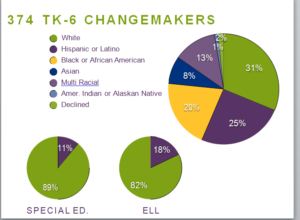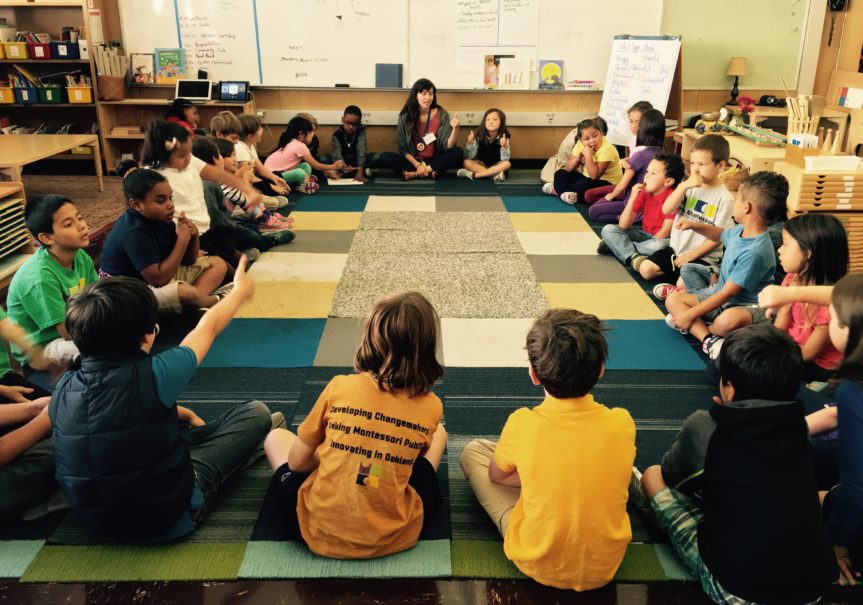“My number one goal is that students are happy and want to come to school.” In this age of test-based accountability those are rare words to hear from a school leader, but I heard them last week at Urban Montessori Charter School, an extraordinary school, that has me thinking.
Schools generally are not very fun, at least the formal parts. And when you review surveys, it’s depressing. Student engagement steadily drops from 5th to 11th grade—where 75% of 5th graders report being engaged, by 11th grade it is a paltry 32%—and this doesn’t even count the kids who have voted with their feet, and stopped showing up.
Particularly in urban areas, with more low income children, schools are often places where a rigid behavioral order is prized. “Good schools” have silent hallways, students sitting up straight, tracking the teacher, and not talking out of turn or to their neighbors. School reform, has long been plagued by an “other people’s children” problem.
The warped view of what low-income, Black and Brown children “need” dominates school designs, by folks who often look nothing like and don’t understand or truly value the experiences of these children or families. While reformer’s children need inquiry based schools that develop the inner child, many schools for “other people’s kids” prize order and compliance.
Take a “Body Break”
This was upside down at Urban Montessori, and I am just so used to the other type of school, that it was a little weird—even though I liked it. Kids came in and out of classes and got up as they pleased, they were eating (and yes spilling) food during class, talking to each other leaning on each other, acting the way kids normally do. Instead of the pin drop atmosphere prized by so many (for other people’s children) it was a beehives buzz of activity.
As I walked through the courtyard a young Brother was running (and I mean running) through it. As unobtrusively as I could I just asked if he was supposed to be somewhere. He paused, “I’m on my body break” and he zipped off.
I looked out the window, I saw several—mostly boys of color- running, getting body breaks. Rather than struggling with kids to keep them seated, the teachers let these birds fly.
And the kids did seem happy, and they were nice to each other. Nothing is ever perfect, but it reminded me how far we have gotten from trying to understand our students and fit the schools to them and their developmental stages. Where mostly we just present these kids with round holes and wear down the edges of their square or octagonal pegs.
At Urban Montessori, young children get up and wander, they lay on the floor, they blurt things out, and talk with their friends—these are all punishable offenses in many elementary schools. It is also normal childhood behavior.
And while in some ways this must be hard as a teacher to let go of the control, it must also make the job easier because you also aren’t policing a predictable range of normal behaviors that somehow became criminalized in the classroom. And you can actually focus on working with students or addressing real issues rather than ones we have made up.
An Integrated School in Oakland
Another striking element (which again speaks to how brainwashed I have become) is that the school was integrated. The apparent racial breakdown looked something like Oakland as a whole, and kids within classes were not self-segregating. I copied a graph on their demographics at the end of the post.
There was also a broad integration of learners in classrooms, it was not apparent which children had special needs or were English learners, everyone was practically learning together—and because the model focuses on individual students, and the school has developed a robust needs identification and support program, many children were getting individualized support. So it’s like all kids are special with individual needs, and without the apparent stigma you sometimes see.
Speaking to staff, all of this was continuing hard and deeply reflective work. Where staff themselves were constantly troubleshooting and designing solutions.
And again I was impressed by the staff’s continuing digging to do better. When I would compliment them, they would say how they needed to keep doing better and talk about that next set of challenges. So yeah they have a good cross section of Oakland attending, but staff noted that achievement gaps persist, and so do opportunity gaps. And those are the issues they are focused upon now.
A better view of school quality
I was painfully reminded of some of my old school monitoring visits—a clipboard in hand counting the number of students “on task” (which really meant who was actually or pretending to pay attention) and coming up with percentages to define engagement/quality. Such crap.
So much of what is defined as school quality has so little to do with real education, the visit today was a pleasant reminder of how far off course we often are. If kids aren’t happy at school, feel those emotional connections, the engagement and eventual self-motivation, then we have failed.
And next time I am asked to do monitoring visit, I am going to ask how we measure happiness.
Demographic makeup of Urban Montessori



Dirk,
Thanks for the great look at a public Montessori school. I posted a link at montessoripublic.org: http://www.montessoripublic.org/2016/10/101717-•-oakland-ca-•-oakland-charter-montessori-school-shout/.
I would be very interested in corresponding with you further about UCMS, charters, and public Montessori in general.
Dave
always happy to chat, you can messageme on twitter @dirktillotson
Thank you for writing about the wonderful things that are happening at Urban, I love that because there are mixed ages in the classroom, my daughter becomes motivated to challenge her self not by the teacher, but by watching what older children are learning. Also children that excel can naturally challenge themselves and teach their peers without having to slow down so everyone can learn the same thing at the same time. My daughter is happy everyday at urban!
PS one important piece of diversity at urban is socioeconomic. All other schools I look at are 95% free lunch or 95% not, I think urban has 40%.
love this feedback from a parent, great to see
Great description, Dirk. If there’s no joy in what we’re doing we’re not doing it right. You’ve described a school where we’d be thrilled to send our own kids.